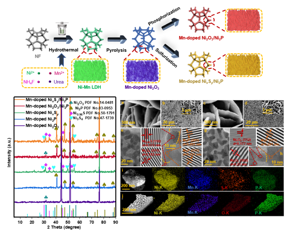Home > Press > Three dimensional Mn-doped NixSy/Ni2P and Mn-doped Ni2O3/Ni2P nanosheets as efficient electrocatalysts for alkaline overall water splitting
 |
| Mn-doped Ni2O3/Ni2P and Mn-doped NixSy/Ni2P are successfully fabricated through hydrothermal reaction and subsequently phosphorization and sulfurization. The characterization results also show that the existence of heterostructures and the corresponding composition of as-fabricated electrocatalysts.
CREDIT ©Science China Press |
Abstract:
Hydrogen has attracted extensive attention from academia and industry as an energy source due to its intrinsic environmental compatibility, abundance, and high energy density (120 MJ kg−1). Electrocatalytic water splitting is an environmentally friendly route to produce hydrogen, especially when the electricity is from renewable sources that minimize carbon dioxide emissions throughout the process. The oxygen evolution reaction (OER) on the anode and hydrogen evolution reaction (HER) on the cathode are two half-reactions in electrocatalytic water splitting. Pt- and Ru/Ir-based compounds are the best-known high-performance noble metal electrocatalysts for HER and OER, respectively. However, the scarcity and high cost of such noble metals hamper their application in water electrolysis. Therefore, with global prospects, it is essential to develop earth-abundant non-noble metal electrocatalysts for next-generation water splitting technologies. Recently, Ni-based electrocatalysts have been confirmed to be effective for boosting electrocatalytic overall water splitting, but their performances are not high enough for large-scale hydrogen production.
Three dimensional Mn-doped NixSy/Ni2P and Mn-doped Ni2O3/Ni2P nanosheets as efficient electrocatalysts for alkaline overall water splitting
Guangzhou, China | Posted on April 8th, 2022
Shis team successfully fabricated Mn-doped Ni2O3/Ni2P and Mn-doped NixSy/Ni2P through facile hydrothermal reaction and subsequently phosphorization and sulfurization method.
The X-ray diffraction (XRD) peaks of Mn-doped NixSy/Ni2P and Mn-doped Ni2O3/Ni2P indicate that Mn-doped NixSy/Ni2P is composed of NixSy and Ni2P, while Mn-doped Ni2O3/Ni2P consists of Ni2O3 and Ni2P. Besides, the scanning electron microscopy (SEM) and transmission electron microscopy (TEM) images both show the nanosheets microstructure of Mn-doped Ni2O3/Ni2P and Mn-doped NixSy/Ni2P. Nevertheless, the heterostructures of Ni2O3/Ni2P and NixSy/Ni2P are confirmed by the high-resolution TEM images.
Benefiting from the electronic modulation and abundant active sites, Mn-doped Ni2O3/Ni2P exhibited superior HER activity with a current density of −10 mA cm−2 at a low overpotential of 104 mV. Meanwhile, Mn-doped NixSy/Ni2P achieved a current density of 100 mA cm−2 at a low overpotential of 290 mV for OER and showed a nearly constant potential at 50 mA cm−2 for 160 h. Interestingly, the electrolytic cell constructed by these two electrocatalysts required a cell voltage of only 1.65 V to afford 10 mA cm−2 with superior stability at 50 mA cm−2 for 120 h.
In conclusion, by combining three strategies, Mn doping, heterostructure engineering, and applying 3D-nanosheet arrays, Mn-doped Ni2O3/Ni2P and Mn-doped NixSy/Ni2P are successfully fabricated by a facile hydrothermal reaction followed by phosphorization, and in the case of Mn-doped NixSy/Ni2P, sulfurization. High intrinsic activities are enabled by electronic modulation of the heterostructures and Mn doping, while abundant active sites are guaranteed by enlarged active surface areas from the 3D-nanosheet arrays. The combination cumulatively enhances the electrocatalytic activities toward HER, OER, and overall water splitting.
####
For more information, please click here
Contacts:
Bei Yan
Science China Press
Office: 86-10-64015905
Expert Contact
Zhicong Shi
Institute of Batteries, School of Materials and Energy, Guangdong University of Technology, Guangzhou, China.
Copyright © Science China Press
If you have a comment, please Contact us.
Issuers of news releases, not 7th Wave, Inc. or Nanotechnology Now, are solely responsible for the accuracy of the content.
News and information
![]()
Nanomedicine for brain cancer April 8th, 2022
![]()
Interdisciplinary team studies challenges and prospects of lithium-CO2 dioxide batteries April 8th, 2022
Possible Futures
![]()
Nanomedicine for brain cancer April 8th, 2022
Discoveries
![]()
USTC found a pathway to high-quality ZnSe quantum wires April 8th, 2022
![]()
Interdisciplinary team studies challenges and prospects of lithium-CO2 dioxide batteries April 8th, 2022
Announcements
![]()
USTC found a pathway to high-quality ZnSe quantum wires April 8th, 2022
![]()
First integrated laser on lithium niobate chip: Research paves the way for high-powered telecommunication systems April 8th, 2022
![]()
Interdisciplinary team studies challenges and prospects of lithium-CO2 dioxide batteries April 8th, 2022
Interviews/Book Reviews/Essays/Reports/Podcasts/Journals/White papers/Posters
![]()
USTC found a pathway to high-quality ZnSe quantum wires April 8th, 2022
![]()
First integrated laser on lithium niobate chip: Research paves the way for high-powered telecommunication systems April 8th, 2022
![]()
Interdisciplinary team studies challenges and prospects of lithium-CO2 dioxide batteries April 8th, 2022
Energy
![]()
USTC found a pathway to high-quality ZnSe quantum wires April 8th, 2022
![]()
Scavenger nanoparticles could make fuel cell-powered vehicles a reality April 1st, 2022
![]()
Workhorse of photovoltaics combined with perovskite in tandem for the first time February 25th, 2022
Water
![]()
A single molecule makes a big splash in the understanding of the two types of water January 7th, 2022
![]()
Water as a metal July 30th, 2021
![]()
Researchers develop new graphene nanochannel water filters January 22nd, 2021










